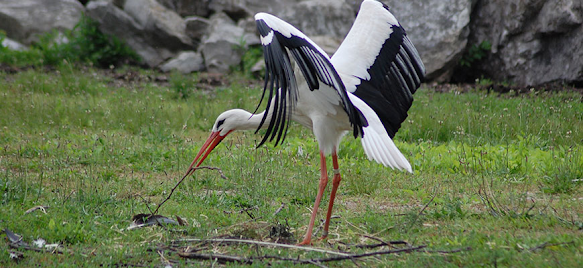In the heart of southern England lies Knepp Castle. A place where nature's magic unfolds. Amongst its ancient grounds, a remarkable rewilding project has turned it into a haven for majestic white storks. These elegant birds, absent from British skies for six centuries, now soar once again, their presence a symbol of hope and resilience.
Laura Vaughan-Hirsch, a dedicated biologist leading the White Stork Project at Knepp Estate, paints a vivid picture of this avian paradise. Nestled high in oak trees, storks' nests the size of tractor wheels stand proudly against the pale blue sky. Here, amidst the tranquil scenery, storks find sanctuary to mate, nest, and raise their young.The journey to this momentous occasion began with just 30 injured storks rescued from Warsaw Zoo in Poland. Nursed back to health at Cotswold Wildlife Park, they were introduced to the rewilded habitat at Knepp. Over time, the colony flourished, reaching 80 individuals at its peak. Witnessing the spectacle, volunteers like Amy Hurn found themselves captivated by these graceful creatures, a testament to the project's success.
But the journey doesn't end here. Since 2019, young storks have embarked on their epic migrations, tracing ancient routes between Britain and North Africa. Equipped with trackers, they navigate perilous landscapes, facing new challenges along the way. Collisions with power lines pose a significant threat to their safety, highlighting the need for innovative solutions to safeguard their journey.
The revival of England's stork population is a triumph over centuries of decline. Once hunted and displaced by habitat loss, these birds have found refuge in the rewilded landscapes of Knepp. Here, biodiversity thrives, with free-roaming deer, pigs, ponies, and cattle sculpting the land into a mosaic of habitats.Jamie Craig, Curator at Cotswolds Wildlife Park, emphasizes the importance of this habitat-rich environment. Abundant insect life sustains storks and other wildlife, creating a perfect haven for these iconic birds. Even the ruins of Knepp Castle bear witness to their return, a testament to nature's resilience.
As autumn arrives, young storks heed the call of migration, soaring to great heights on thermal currents. Their journey takes them across the English Channel to Spain, Portugal, and Morocco, where new adventures await. Yet, amidst the awe-inspiring spectacle, dangers lurk in the form of power lines and pylons.
Fortunately, research offers hope for their safety. Insulating pylons can prevent electrocution, reducing the risk of fatalities. Across Europe, initiatives like stork villages demonstrate the power of community-led conservation efforts in protecting these majestic birds.Beyond the challenges, migration holds the promise of new connections and discoveries. Aldina Franco, an ecologist tracking the storks' movements, envisions a future where people across continents unite to safeguard their habitats. From school visits to guided stork safaris, efforts to raise awareness and foster conservation are underway.
As we gaze upon the storks' nests, a timeless symbol of resilience and renewal, we are reminded of our role as stewards of the Earth. In their journey, we find inspiration to protect not just these magnificent birds, but the delicate ecosystems they inhabit. Together, we can ensure that England's white storks continue to grace our skies for generations to come. Stay tuned for more eclipse updates and tips on our blog, Earthecho360. Let's make memories.








0 Comments